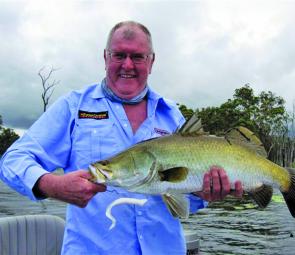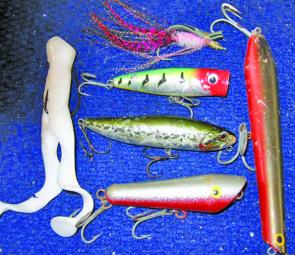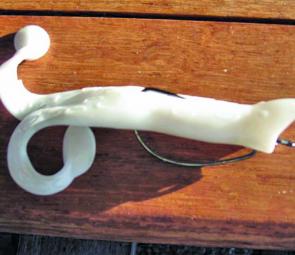Addictions are not something that we readily admit to having, but there is one addiction that I have happily had for many years, catching fish on surface lures.
My addiction goes back over 20 years and started when catching trevally and queenfish around the Hay Point coal loading jetty. Back then there were no closures around the jetty and we would regularly cruise along beside the jetty and cast big poppers in under the pylons and get monstered by trevally.
Since then my addiction has grown and no applies to many more fish species in both fresh and saltwater; with each catch firmly etched in the memory bank. Among those are heaps of barra in salt and freshwater, oodles of sooties, the odd forky catfish, trevally, queenfish, small macks, tuna, long tom, jacks, flathead, cod, and a few assorted small reefies.
With that sort of range, it is obvious that surface luring is quite productive and I am always amazed when anglers tell me that they don’t use surface lures much. They don’t know what they are missing out on, as even after all these years, I get a terrific buzz out of catching fish on the surface, and it is still one of my preferred luring styles.
Naturally one surface lure will not do for all these species, hence my excuse for buying more different types all the time.
I use mainly hardbody lures in three styles: cup faced poppers, pencil style poppers and walk the dog types. Each has particular applications, although the first and last can be used for much the same species and retrieve styles. Pencil poppers by their design are meant to imitate slim bait like garfish and pike.
Pencil poppers are at their best when worked with a fast erratic retrieve that sees the lure dancing all over the surface at high speed. Some types will pop under the surface briefly and then burst out onto the surface again, and many saltwater pelagics can’t resist them. These poppers can also be successfully trolled at quite high speeds when chasing pelagics.
Tunas, queenfish, small macks, Spanish macks, cobia and trevally are all predators with a good turn of speed and all feed actively on garfish and the like, hence are obvious targets for the pencil popper. Ensure the poppers are fitted with good strong eyelets, split rings and hooks as many of the cheaper imported types are just not tough enough for these species.
Cup faced poppers can also be worked at speed and my best ever longtail tuna was taken up near Montes resort on a cup face. That tuna was around 10kg and took the popper in about 2m deep water on a bait caster. These lures can also be worked super slowly to antagonise a fish into striking and when combined with tidal run can be made to just about sit in the one spot.
When fishing down current to a rock or snag either around the islands or in a creek, the popper can be cast to the snag, let drift right onto it then blooped out a bit, stopped and let drift back in again. This can be very effective for barra, cod and trevally; I think the fish gets to the point where they hammer the lure out of frustration, or they just can’t help themselves.
Cup face poppers work well in freshwater also, but here is the time to slow it right down. Barra in the dams and lagoons are an obvious target, but remember they are lazy so work the lure super slowly. I like to cast and let the lure sit while I count to 20, then just give it a bit of a nudge and let it sit again. Keep this up as barra in particular will often sit just under the popper and watch it for some time before smashing it and frightening the daylights out of the angler.
Most barra hits on poppers come while the lure is doing nothing, just sitting there floating.
This brings us to the third type of lure, the walk the dog style. Here the Tango Dancer is absolutely the top dog. This great lure has good action, good hardware and an enviable reputation for catching barra. I will not go chasing barra without these lures on hand, and I have lost count of how many I have caught on them. Sooties also seem to delight in smashing at them.
Tango Dancers can be fished effectively several different ways. Hold the rod tip down and a steady retrieve working the rod tip will see the lure zig zag across the surface, then stop and the lures sits bum down and bobs up and down, which is when the most strikes happen.
Alternatively take up the slack, rip the rod to one side and then point it straight back at the lure. The lure will skitter then stop bum down and bob. The skitter is a good imitation of a bony bream or in saltwater a mullet or gar.
That about covers the hardbody types, but I have long wished for a soft plastic type popper but those I have tried seem too heavy to be buoyant enough to float and they needed to me worked fast to keep them on top. The other day while browsing in Tackleworld in Mackay I spotted some new plastic frogs that I had not seen before. Yes, I have fished with frogs plenty of times but these were different.
A close look revealed a cup face and a fairly bulky body with very flexible legs. Colours were white and a very dark green, and after pulling one out of the packet for a look, I beat a path to the cash register with a packet of each colour, as I could see plenty of potential there.
The brand is Z-Man Pop Frogz in the 6” (150mm) size. Rigged with an offset work style hook, they looked the goods and I could not wait to give them a swim. A quick trip to Teemburra dam was the ideal opportunity, and they sure do look great in the water and best of all they float. The cup face can be blooped if you want, and when the lure stops, those flexible legs keep up a small movement.
A barra about 76cm smacked a white one only a couple of metres from the boat and after a short powerful performance was in the landing net. The frog had shot up the leader and was out of harms way, while the hook was firmly in the corner of the jaw. I really like these lures and can see them getting plenty of swim time out of my boat.
I reckon smaller size ones would be absolutely deadly on sooties, as they land with a nice distinctive plop that sooties seem to prefer. They can be cast up into all manner of cover and seem to be pretty strongly made.
My recommendation: get some and try them out!!
Lure fishers are not the only ones who are fortunate to be able to fish with poppers, as there are a number of patterns for the fly angler too. Small cork poppers are readily available and most seem to have a feather or two as a tail, but watch the quality of the hooks as many of them come with hooks that would not stand up to a decent fish like a good sooty or a barra.
Foam body poppers and fizzers are also pretty easy to tie up, but my favourite fly for surface work is a Garside Gurgler or variations on the theme. These things are magic and I have watched Wayne Kampe hammer barra, sooties and Murray cod on them. I usually tie them with extra flashy stuff from the front of the fly also to try to give the impression of more bulk while keeping the fly fairly easy to cast.
So there you have a run down on my favourite way to fish and this is one addiction I thoroughly recommend. Get yourself down to the tackle shop, get some surface lures (including those Pop FrogZ) and go out there and have a heap of fun. See you at the ramp.
Reads: 3361
This 76cm barra nailed a Z-Man Pop Frogz in white from Teemburra Dam.

A selection of all the different types of surface lures. From top, Garside Gurgler, cupfaced popper, Tango Dancer and Mr Poppas Blooper; to the left a Z-Mans Frogz; and to the right a Mr Poppas Pencil popper.

A close up of a Z-Mans Pop Frogz – my new favourite surface lure.




